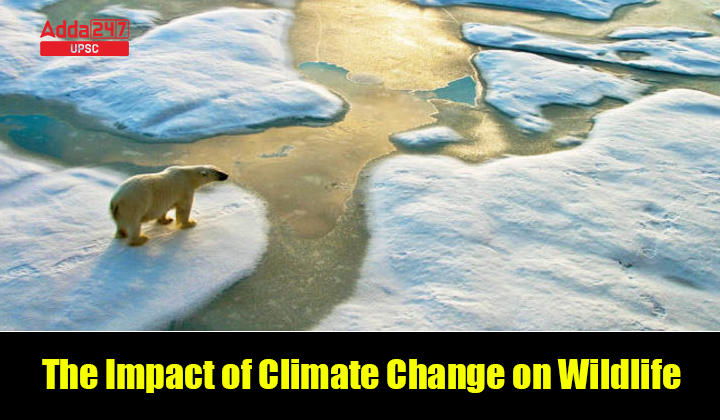Table of Contents
Climate Change on Wildlife: Undoubtedly, climate change poses a grave threat to our planet in the present era. Its consequences are evident worldwide, manifested through escalating sea levels, intensified and frequent weather calamities, as well as alterations in ecosystems, and the decline of biodiversity.
Amidst the diverse array of living organisms impacted by climate change, wildlife stands out as exceptionally susceptible. Fluctuations in temperature, patterns of precipitation, and other ecological factors are exerting a profound influence on the habitats, migratory routes, and population sizes of numerous species. Consequently, wildlife confronts an array of perils ranging from the degradation and fragmentation of habitats to the dwindling numbers and potential extinction of various species.
Also Read: Animal Pandemic Preparedness Initiative (APPI)
Understanding Climate Change
Before delving into the effects on wildlife, it’s crucial to understand the fundamentals of climate change. The Earth’s climate has always fluctuated, but human activities, primarily the burning of fossil fuels, have intensified the greenhouse effect, leading to rapid changes in temperature and weather patterns. These changes have far-reaching implications for both the environment and the species that inhabit it.
Climate Change and Wildlife
Climate change has profound effects on wildlife, altering their habitats, behavior, and interactions with other species. One of the most significant concerns is the disruption of ecosystems and the potential collapse of delicate food chains. As temperatures rise, wildlife must adapt to new conditions or face extinction.
Also Read: Stand-Up India Scheme Extended
Effects on Habitats and Ecosystems
Rising temperatures and changing precipitation patterns lead to shifts in ecosystems and the availability of resources. Habitats that once provided ideal conditions for various species are no longer suitable, leading to habitat loss and fragmentation. This loss of habitat affects a wide range of wildlife, from birds and mammals to insects and plants, creating a ripple effect throughout the ecosystem.
Disruption of Migration Patterns
Many species rely on seasonal migration for breeding, feeding, and finding suitable habitats. However, climate change disrupts these migration patterns. As temperatures shift and the timing of seasons changes, wildlife may struggle to find adequate resources along their traditional migration routes. This can lead to decreased reproductive success and population declines.
Changes in Species Distribution
Climate change is also causing shifts in species distribution. As temperature zones shift, some species are forced to move to higher latitudes or altitudes to find suitable conditions. This migration can lead to increased competition between species, potential conflicts with human settlements, and the loss of native species in certain regions.
Impact on Endangered Species
Endangered species are particularly vulnerable to the impacts of climate change. These species already face numerous threats, such as habitat destruction and poaching, and climate change exacerbates their precarious situation. Rising sea levels, changing precipitation patterns, and loss of suitable habitats can push endangered species further toward extinction.
Climate Change Threats to Biodiversity
Biodiversity, the variety of life on Earth, is under significant threat due to climate change. As habitats change and species struggle to adapt, the loss of biodiversity becomes a pressing concern. A decrease in biodiversity not only disrupts ecosystem stability but also diminishes the potential for scientific discoveries and the development of new medicines derived from natural resources.
Altered Reproduction and Breeding Patterns
As temperature and weather patterns fluctuate, many species experience changes in their reproductive cycles. For example, shifts in rainfall patterns can impact the availability of water sources crucial for breeding and raising offspring. Additionally, changes in temperature can disrupt the synchronization between species that rely on specific environmental cues for mating and reproduction. These alterations in reproductive patterns can lead to decreased reproductive success, population decline, and even local extinctions.
Shifts in Food Availability
Climate change also influences the availability of food sources for wildlife. As temperature and precipitation patterns change, it affects the growth and distribution of plants and alters the behavior and abundance of prey species. This, in turn, affects the survival and reproductive success of predators and other organisms higher up the food chain. Disruptions in food availability can lead to imbalances in ecosystems, affecting the overall health and stability of wildlife populations.
Climate Change and Marine Life
Marine ecosystems are equally susceptible to the impacts of climate change. Rising sea temperatures and ocean acidification pose significant challenges for marine life. Coral reefs, for instance, are highly sensitive to even small increases in temperature, leading to coral bleaching events and the subsequent loss of habitat and biodiversity. Moreover, warmer waters can alter the migration patterns of fish species, affecting fisheries and the livelihoods of coastal communities.
Conservation Efforts and Adaptation Strategies
Recognizing the urgency of addressing climate change, conservation organizations and governments worldwide are implementing various strategies to mitigate its impacts on wildlife. These efforts include the establishment of protected areas, habitat restoration projects, and the promotion of sustainable practices to reduce carbon emissions. Additionally, scientists and researchers are studying species’ adaptability to changing conditions, which can inform conservation strategies and help species adjust to a rapidly changing world.
Climate Change & Role of Human Activities
Human activities, particularly the burning of fossil fuels, deforestation, and intensive agriculture, are the primary drivers of climate change. By significantly contributing to greenhouse gas emissions, humans have accelerated the pace of global warming and its subsequent effects on wildlife. Recognizing this, it is essential for individuals, communities, and governments to take responsibility and adopt sustainable practices that minimize the impact on the environment and protect wildlife habitats.
Conclusion
The impact of climate change on wildlife is far-reaching and poses significant threats to biodiversity and ecosystem stability. From altered habitats and disrupted migration patterns to changes in reproductive cycles and shifts in food availability, wildlife populations face numerous challenges in a changing climate. Urgent action is necessary to mitigate climate change and protect vulnerable species, their habitats, and the intricate web of life on our planet.


 UPSC Eligibility Criteria 2024- Age Limi...
UPSC Eligibility Criteria 2024- Age Limi...
 UPSC Prelims Exam Date 2024, Check New E...
UPSC Prelims Exam Date 2024, Check New E...
 UKPSC RO ARO Result 2024 Out, Download M...
UKPSC RO ARO Result 2024 Out, Download M...







